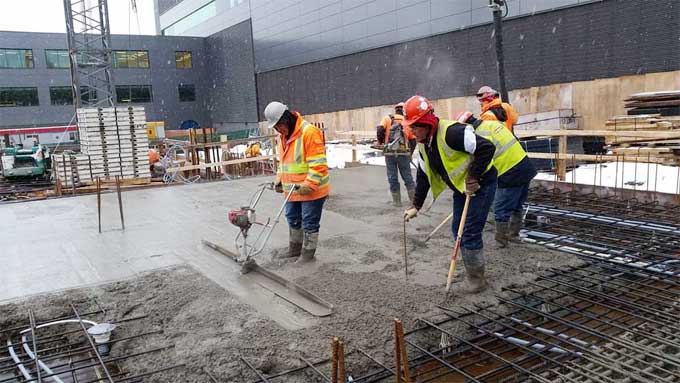
Avoid these 7 concrete placing mistakes when working in cold weather

To ensure concrete's durability and ultimate strength, it needs to be placed at the right temperature. Concrete's workability and ultimate strength will both be significantly reduced at temperatures above the normal curing range.
Furthermore, low temperatures can result in irreversible strength loss. The resulting durable and strength issues may require costly repairs and rehabilitation if concrete is poured at the wrong temperature.
Risk of placing concrete in Cold Weather
Crack Development: When concrete is exposed to low temperatures, it can chip, flake, and crack.
Strength Loss: Because of the increased volume of water created when moisture is frozen inside concrete, the concrete can be damaged. Concrete can be damaged by ice immediately if it is exposed to it.
While this concrete is hard to see when inside, it is highly likely to crumble when heavy loads are applied to it. Approximately half of the expected 28-day strength will be lost if freezing occurs during the first 24 hours after concrete placement. Strength and durability are lost as a result of freezing temperatures.
Humidity Loss: Additionally, temperatures below 5 ?C slow down the hydration process or the curing process. A reduction in strength development and an extension of the construction schedule may result as a result.
Avoid Mistake While Working in Cold Weather
Keep your concrete Warm: For concrete to cure properly, it needs to be kept at a temperature of 50?F or 10?C. Until fresh concrete has the appropriate compressive strength measurement, it is necessary to warm it up to 25?F or -4?C. Using a concrete temperature and maturity meter will make this process more efficient.
Heater Use: For concrete to continue curing and develop strength, it needs to remain warm. When your slab's temperature drops too low, then curing stops. By adding extra heat directly to the concrete, portable heaters ensure that it continues to cure and gain strength. When using heat, be careful not to overheat the concrete, as this can lead to a weak structure.
Real Time Temperature Sensors Use: It is important to monitor the temperature of cold weather concrete in order to ensure high-quality concrete that meets the requirements of the thermal control plan. In the absence of proper attention to the strength development of the concrete, several common problems can occur. Concrete freezing at early ages, lack of strength, rapid temperature changes, inadequate protection of structures, and improper curing are some of these problems.
Real-time temperature sensors can prevent these problems related to pouring concrete in winter by ensuring that the optimal temperature of concrete is maintained throughout the curing process. Cold weather mass concrete applications require ensuring your concrete doesn't freeze, your temperature differential is maintained under specific limits, your maximum temperature does not exceed the maximum limit, and your concrete gains strength properly.
Concrete Effectiveness in Cold Weather: Concrete curing conditions are influenced by the placement of the slab when placing concrete. Ground that has been frozen can settle when thawed, causing the concrete to crack. Similarly, fresh concrete closest to the ground will cure slower than concrete farther away, resulting in a slab with a hard top but a softer bottom.
Due to the different temperature gradients, concrete with different strengths does not develop adequately, leading to cracks and possible structural damage.
Cold Tool Use: The tools and materials you use to build are just as important as the concrete itself. A cold form or tool could alter the concrete that comes into contact with it. Concrete poured in cold weather can suffer from this issue, negatively affecting the strength development of your slab.
To learn more, watch the following video tutorial.
Video Source: For Construction Pros
Daylight Saving: The amount of daylight decreases during the colder months. Running behind schedule can lead to more problems if you fail to use your time wisely. In addition to supplying you with tons of light, daylight also warms the atmosphere. It is necessary to place concrete before or after daylight hours.
Weather Condition: Your concrete will be more resistant to weather exposure and other outside elements when sealed.
When you are placing concrete in cold weather, then the manufacturer or producer recommends of using a sealer that can withstand extreme weather conditions. Temperatures below 50?F or 10?C should not be used for sealing.


